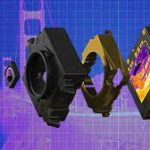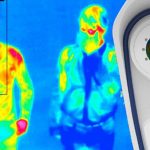There are several types of thermal optics, but the main distinction is that they depend on different sources for their imaging. Thermal infrared (TIR) imagery comes from thermal radiation emitted by objects. This happens because all objects above 0 kelvin (~ -273 degrees C) will emit infrared radiation due to the object’s heat energy. As a result, thermographic cameras can see heat given off by objects, which has been used for military purposes in night vision goggles and post-thermal event surveillance photography. In fact, TIR imagery is also used in astronomy where astronomers observe distant galaxies with infra-red telescopes that detect the infra-red wavelength given off by these celestial bodies.
Drawing of a black body radiator, or an object that emits thermal radiation
The other types of non-TIR imagery use light sources like lasers in order to highlight objects. Laser detection and ranging (LADAR) is one example in which the natural reflected laser beams are detected with a sensor in order to identify the location, size, shape, speed and trajectory of an object. LADAR can be done using infrared lasers due to its ability to penetrate fog and rain better than regular visible light. Its major drawback is its difficulty in identifying objects when it’s dark since there’s less contrast between the target object and the background; it may also take more time than TIR imaging for LADAR sensors to objects at long range. Another laser-based technology is lidar, which stands for light detection and ranging. In this case, a single laser sends out beams of light that hit the target object in order to analyze its properties, similar to how radar uses radio waves instead of lasers to determine an object’s position or velocity. Lidar can be used in a helicopter to help control the flight path of the aircraft since it’s possible for a pilot to have difficulty seeing certain obscured obstacles in low visibility conditions such as fog. Finally, there are radar guns used by police officers in order to detect the speed of a vehicle by measuring the change in frequency that occurs when reflected radio waves bounce off a car or other moving objects. In each case where either lasers or microwaves are used to detect an object, they have the advantage of being able to see through most atmospheric conditions, which makes them popular for military and law enforcement applications.
Radar speed gun
The last type of thermal infrared imagery is called focal plane array (FPA) imaging. In this case, the thermal radiation from the target object hits a microbolometer embedded in a sensor chip instead of individual pixels as in traditional cameras. The amount of electric current passing through each pixel changes depending on how much heat that part of the sensor chip receives. This difference occurs because specific parts of the microbolometer will either transmit or absorb more energy given off by an object’s temperature; some parts will even do both. All of this data on the electrical currents passing through each microbolometer pixel is then translated into an image using a special analog-to-digital converter, similar to how regular visible light cameras work with their sensors and pixels. This type of thermal imagery can be used for law enforcement since it’s possible to observe people at long ranges without them noticing they’re being observed since there’s no bright flash or loud noise associated with FPA imaging like what you see in TIR and LADAR images given off by lasers and microwaves. It also makes it easier for observers to detect small changes in temperature such as those produced by breathing, which often isn’t possible with TIR and LADAR technologies that require higher contrasts between the object’s temperature and the background. Like LADAR, its main weakness is that it doesn’t work at night or in other low visibility conditions since FPA can’t produce enough of a contrast between the target object and its surroundings.


